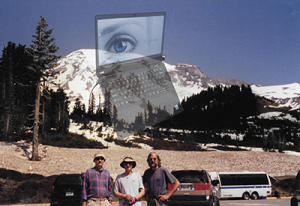How a Mt. Rainier Hike Led to a Trailblazing Lie Detection Invention
Drs. John Kircher and Doug Hacker could not have known a conversation en route from Salt Lake City to Mt. Rainier would be the catalyst for inventing a completely new way to accurately detect deception. Their story is now available in the recently released Converus origin story.

Left to right: Don Krapohl with Drs. John Kircher and Doug Hacker, prior to hiking Mt. Rainier the summer of 2002. It was during the drive from Salt Lake City that Kircher and Hacker began discussing the concept of creating a new lie detection method that could detect deception from a person’s eyes.
LEHI, Utah – Jan. 30, 2024 – Except for transitioning from an analog to a computerized test in 1991, polygraph technology remained largely unchanged while retaining its place as the de facto lie detector since its invention in 1921.
According to the recently released Converus origin story, that all began to change in the summer of 2002. That’s when Dr. John Kircher, a noted polygraph expert also credited with co-inventing the computerized polygraph, and his colleague Dr. Doug Hacker embarked to climb Mt. Rainier in Washington state. During the 12-hour drive from Salt Lake City — where the two scientists worked at the University of Utah — they discussed new approaches to deception detection. Inspired by previous eye tracking research of others, along with Hacker’s background as an educational psychologist with expertise in writing and reading comprehension processes, they specifically wondered if lies could be accurately detected from the eyes.
Upon arriving at Mt. Rainier, they met with another climber, Don Krapohl. The research scientists shared with Krapohl their idea about detecting lies from the eyes. Krapohl, who at the time was a U.S. federal polygraph examiner, was intrigued and wanted to hear more.
“This was a novel concept,” remembered Krapohl when first presented with this concept. Up to this time, measuring changes in eye behavior caused by changes in a person’s cognitive load during a true/false test had never previously been done. “I immediately recognized it would be a completely new way to detect deception — if it was accurate.”
Within two weeks after returning to the University of Utah, Kircher and Hacker began researching the new concept in their lab. Soon three other scientists with additional expertise in eye-tracking equipment, test construction, and criminal investigations joined the effort.
“It took our science team more than a decade to conduct research, test and retest our concept, develop a protocol and refine the computer algorithms until we were able to support beyond a reasonable doubt that we could accurately detect deception from a person’s involuntary eye behavior,” said Kircher.
In 2010, the University of Utah licensed the technology to a local tech startup, later renamed Converus. Converus branded the technology “EyeDetect,” which was officially released to the world in 2014. EyeDetect is an automated, computer-based lie detection technology that uses an eye-tracking camera to measure changes in a person’s involuntary eye behavior during an automated 15- to 30-minute true/false or yes/no test. At the completion of a test, the test data are uploaded to the cloud where computer algorithms determine if the person is credible or deceptive.
EyeDetect is now used by more than 600 customers in 60 countries to screen potential and existing employees for involvement in serious crimes, drug use, sabotage, espionage, terrorism and other criminal and unethical behaviors. Customers include 90 U.S. law enforcement agencies.
“Over the years, we’ve received calls from defense attorneys involved in high-profile cases requesting to use EyeDetect to determine if their client is innocent or guilty,” said Converus President and CEO Todd Mickelsen. “EyeDetect also helps private investigators solve difficult crimes far quicker. And just recently this technology was even used on an Olympic pole vaulter to exonerate him of false doping allegations.”
“It’s remarkable what a simple question can sometimes lead to,” said Hacker. “It’s an honor to have been a part of this team.”
Added Krapohl, “I’m glad to be included in the history of John and Doug’s great innovation. Their concept changed the entire paradigm of the lie detection world.”
For more information, visit: converus.com
# # #
About Converus®
Converus provides scientifically validated credibility assessment technologies. VerifEye™ is the world’s first mobile app to help organizations or individuals accurately verify the truth about a person — including background, identity, creditworthiness and claims — in about 10 minutes. EyeDetect®, which detects deception by measuring involuntary eye behavior, is a fast, accurate, affordable, noncontact, scalable, and fully automated option to polygraph. EyeDetect+ is the world’s first automated polygraph, making the testing process impartial, accurate, and less intrusive (than a traditional polygraph). It assesses credibility by monitoring and recording ocular activity plus physiological activity similar to a traditional polygraph. Customers worldwide use the EyeDetect product line for screening and investigations to help protect countries, corporations and communities from corruption, crime and threats. Converus is headquartered in Lehi, Utah, USA. Visit converus.com
______________________________________________________________________
Press Contact: Jeff Pizzino, APR (+1 480-606-8292 or [email protected])

